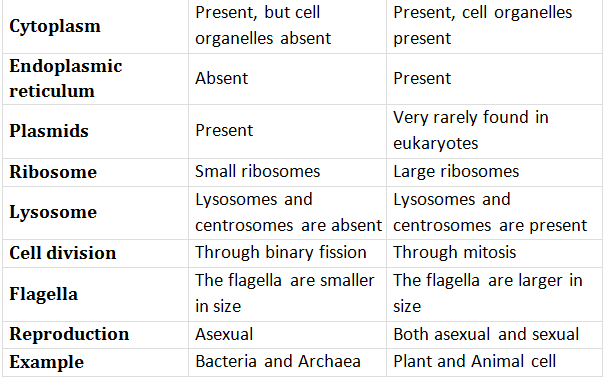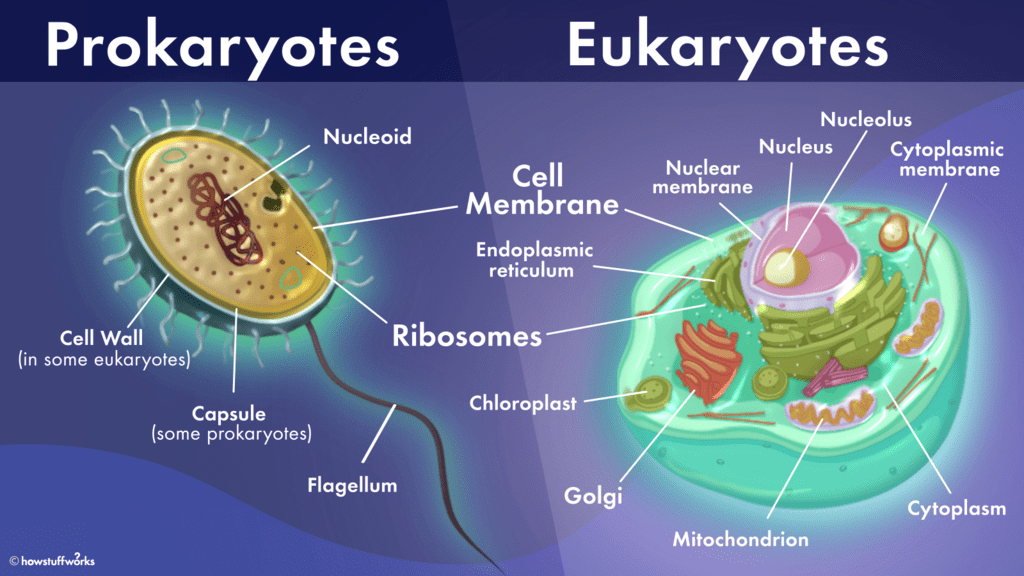Difference between Prokaryotic & Eukaryotic Cells - Class 11 PDF Download
| Table of contents |

|
| Introduction |

|
| Prokaryotic Cell |

|
| Eukaryotic Cell |

|
| Frequently Asked Questions |

|
Introduction
Biotic components of the environment include all forms of life from minute bacteria to towering giant Sequoias. However, at the microscopic level, all living organisms are made up of the same basic unit – the cell.
Contents
- Prokaryotic Cell
- Eukaryotic Cell
- Difference between Prokaryotic and Eukaryotic Cells

Eventual advancements in science and technology shed more light into the cell, with new findings and discoveries about its structure and cellular components. During the 1950s, scientists postulated the concept of prokaryotic cell and eukaryotic cell, with earlier groundwork being laid by Edouard Chatton, a French Biologist in 1925.
Anatomically, cells vary with respect to their classification, therefore, prokaryotic cells and eukaryotic cells differ from each other quite drastically. Read on to explore how they differ from each other.
Prokaryotic Cell
- The term “prokaryote” is derived from the Greek word “pro“, (meaning: before) and “karyon” (meaning: kernel). It translates to “before nuclei.“
- Prokaryotes are one of the most ancient groups of living organisms on earth, with fossil records dating back to almost 3.5 billion years ago. These prokaryotes thrived in the earth’s ancient environment, some using up chemical energy and others using the sun’s energy.
- These extremophiles thrived for millions of years, evolving and adapting. Scientists speculate that these organisms gave rise to the eukaryotes.
- Prokaryotic cells are comparatively smaller and much simpler than eukaryotic cells. The other defining characteristic of prokaryotic cells is that it does not possess membrane-bound cell organelles such as a nucleus. Reproduction happens through the process of binary fission.
- Structurally, prokaryotes have a capsule enveloping its entire body, and it functions as a protective coat. This is crucial for preventing the process of phagocytosis (where the bacteria gets engulfed by other eukaryotic cells, such as macrophages) The pilus is a hair-like appendage found on the external surface of most prokaryotes and it helps the organism to attach itself to various environments. The pilus essentially resists being flushed, hence, it is also called attachment pili. It is commonly observed in bacteria.
- Right below the protective coating lies the cell wall, which provides strength and rigidity to the cell. Further down lies the cytoplasm that helps in cellular growth, and this is contained within the plasma membrane, which separates the interior contents of the cell from the outside environment. Within the cytoplasm, ribosomes exist and it plays an important role in protein synthesis. It is also one of the smallest components within the cell.
- Some prokaryotic cells contain special structures called mesosomes which assist in cellular respiration. Most prokaryotes also contain plasmids, which contains small, circular pieces of DNA. To help with locomotion, flagella are present, though, pilus can also serve as an aid for locomotion.
Common examples of Prokaryotic organisms are bacteria and archaea. Also, all members of Kingdom Monera are prokaryotes.
Eukaryotic Cell
- The term “Eukaryotes” is derived from the Greek word “eu“, (meaning: good) and “karyon” (meaning: kernel), therefore, translating to “good or true nuclei.” Eukaryotes are more complex and much larger than the prokaryotes. They include almost all the major kingdoms except kingdom monera.
- Structurally, eukaryotes possess a cell wall, which supports and protects the plasma membrane. The cell is surrounded by the plasma membrane and it controls the entry and exit of certain substances. The nucleus contains DNA, which is responsible for storing all genetic information.
- The nucleus is surrounded by the nuclear membrane. Within the nucleus exists the nucleolus, and it plays a crucial role in synthesising proteins. Eukaryotic cells also contain mitochondria, which are responsible for the creation of energy, which is then utilized by the cell.
- Present in only plant cells, chloroplasts are the subcellular sites of photosynthesis. Endoplasmic reticulum helps in the transportation of materials. Besides these, there are also other cell organelles that perform various other functions and these include ribosomes, lysosomes, Golgi bodies, cytoplasm, chromosomes, vacuoles and centrosomes.
- Examples of eukaryotes include almost every unicellular organism with a nucleus and all multicellular organisms.
Difference between Prokaryotic and Eukaryotic Cells
Though these two classes of cells are quite different, they do possess some common characteristics. For instance, both possess cell membrane and ribosomes, but the similarities end there.
The complete list of differences between prokaryotic and eukaryotic cells are summarized as follows:

Frequently Asked Questions
Q.1. What is a Prokaryotic cell?
Ans. A prokaryotic cell is a primitive type of cell that is characterized by the absence of a nucleus. Furthermore, prokaryotes do not possess membrane-bound cellular organelles. Prokaryotes are exclusively unicellular.
Q.2. What is a Eukaryotic cell?
Ans. Eukaryotic cells are cells that possess a true nucleus along with membrane-bound organelles. Eukaryotes can either be unicellular or multicellular.
Q.3. What is the difference between Prokaryotic and Eukaryotic cell?
Ans.The defining characteristic feature that distinguishes between prokaryotic and eukaryotic cell is the nucleus. In prokaryotic cells, the true nucleus is absent, moreover, membrane-bound organelles are present only in eukaryotic cells. Other major differences between prokaryotic and eukaryotic cells are that prokaryotic cells are exclusively unicellular, while the same does not apply to eukaryotic cells.
Q.4. Define Cell?
Ans. The cell is the basic functional and structural unit of life. Cell plays a vital role in all biological activities and include membrane-bound organelles, which perform several individual functions to keep the cell alive and active.
Q.5. What is Ribosome?
Ans. The ribosome is a multi-component cell organelle consisting of RNA and protein. Therefore, it is called the site of protein synthesis. Ribosomes are present both in prokaryotic and eukaryotic cells. Compared to prokaryotes, eukaryotes have larger ribosomes in their cells.
Q.6. List out the unique features of Animal and Plant Cells.
Ans. Both animal and plant cells have several unique features. Listed below are some important features:
- In structure, both animal and plant cells are quite similar.
- Both possess nucleus and plasma membrane, a selectively permeable membrane of the cell.
- Both animal and plant cells include membrane-bound organelles with their specialized functions.
- Animal and plant cells have vacuoles, which serve as the storage unit and maintain the shape of the cell.
- Mitochondria is the powerhouse of the cell. It stores and provide energy for different cellular activities and is found both in both animal and plant cells.
Q.7. List out the functions of Chloroplasts.
Ans. Chloroplasts are the plastids found in all plant cells. These cell organelles comprise the photosynthetic pigment called chlorophyll and are involved in synthesizing food by the process of photosynthesis.
Q.8. Who discovered Cell and Cell Theory?
Ans. The cell was first discovered in the year 1665 by an English natural philosopher Robert Hooke. The Cell Theory was explained by Theodor Schwann and Matthias Jakob Schleiden in the year 1830.
FAQs on Difference between Prokaryotic & Eukaryotic Cells - Class 11
| 1. What are the main differences between prokaryotic and eukaryotic cells? |  |
| 2. How do prokaryotic and eukaryotic cells differ in terms of reproduction? |  |
| 3. Can prokaryotic cells perform the same functions as eukaryotic cells? |  |
| 4. Are all bacteria examples of prokaryotic cells? |  |
| 5. How do prokaryotic and eukaryotic cells differ in terms of their genetic material? |  |

|
Explore Courses for Class 11 exam
|

|


















